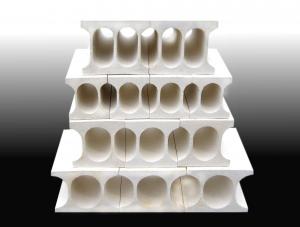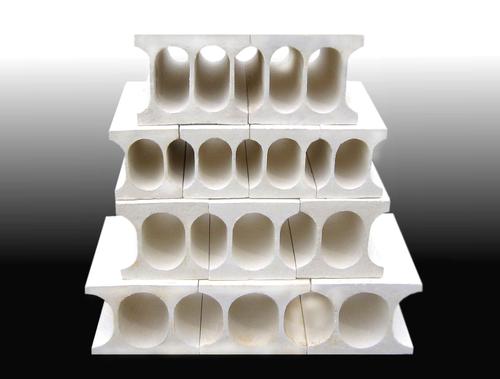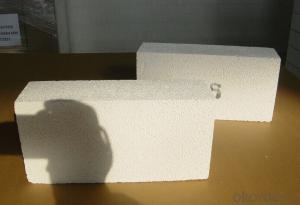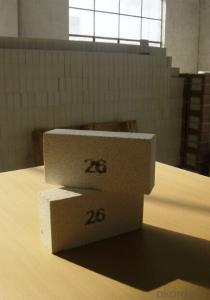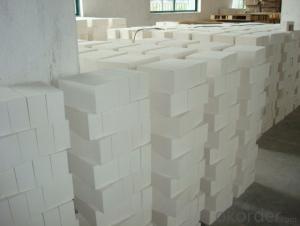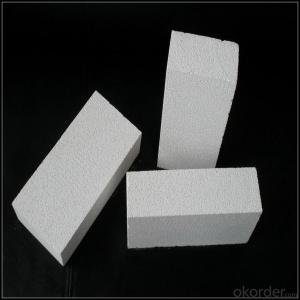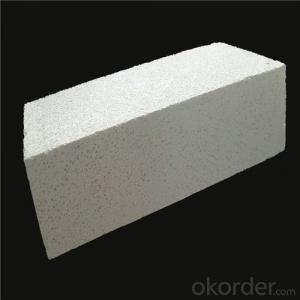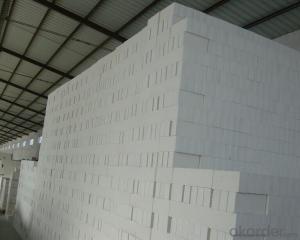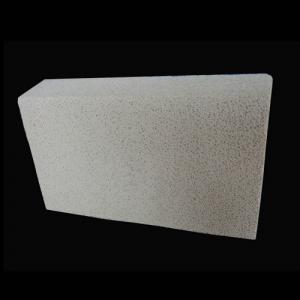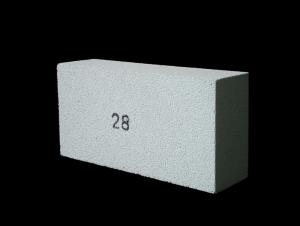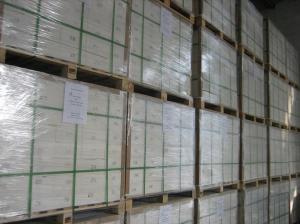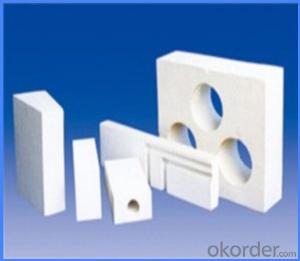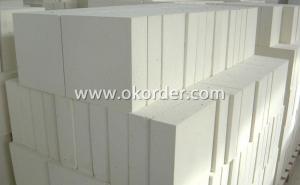Insulating Fire Brick GJM23 - High-Quality Insulation for Fire Safety
- Loading Port:
- China Main Port
- Payment Terms:
- TT OR LC
- Min Order Qty:
- -
- Supply Capability:
- -
OKorder Service Pledge
Quality Product, Order Online Tracking, Timely Delivery
OKorder Financial Service
Credit Rating, Credit Services, Credit Purchasing
You Might Also Like
General Information
CMAX insulating firebricks are classified under temperature between 1300℃ to 1700℃, manufactured from high purity alumina clay.
Feature
Light weight and low thermal conductivity
Low heat storage
Low iron and impurities
High thermal shock resistance
Application
CMAX insulating firebricks can be used as a hot face lining directly exposed to the heat or as a backup insulation layer in iron and steel mills, non-ferrous foundries, petrochemical, ceramic, glass.
- Q: Are insulating fire bricks resistant to thermal shock cracking?
- Yes, insulating fire bricks are resistant to thermal shock cracking. These bricks are specifically designed to withstand high temperatures and rapid changes in temperature without cracking. They have a low thermal conductivity, which means they can effectively trap and retain heat without being damaged by thermal shock. Insulating fire bricks are often used in applications where thermal shock is a concern, such as in furnaces, kilns, and other high-temperature environments. Their resistance to thermal shock cracking makes them a reliable choice for these types of applications.
- Q: Can insulating fire bricks be used in the construction of flue gas ducts?
- Insulating fire bricks have the capability to be utilized in the construction of flue gas ducts. These bricks are specifically engineered to endure high temperatures and offer exceptional thermal insulation. This makes them an apt choice for lining flue gas ducts as they aid in reducing heat loss and enhancing energy efficiency. Moreover, insulating fire bricks exhibit resistance to chemical corrosion and can withstand the harmful impacts of flue gases. Nevertheless, it is crucial to guarantee that the insulating fire bricks employed are specifically designed for flue gas duct applications and fulfill the required safety and regulatory standards. Seeking advice from a professional engineer or a specialist in this field is advised to ensure the accurate selection and installation of insulating fire bricks in flue gas ducts.
- Q: Do insulating fire bricks have a high electrical resistivity?
- Insulating fire bricks are generally characterized by their high electrical resistivity. This characteristic arises from their specific design, which aims to minimize thermal conductivity and maximize thermal resistance. Consequently, the insulating materials employed in these bricks, including alumina, silica, and other refractory materials, exhibit inherently high electrical resistivity. Moreover, the manufacturing procedures frequently incorporate the incorporation of insulating additives, thereby augmenting the electrical resistivity of the fire bricks. Consequently, insulating fire bricks prove to be highly effective in mitigating heat transfer and sustaining elevated temperatures across diverse industrial applications, such as kilns, furnaces, and thermal insulation systems.
- Q: Can insulating fire bricks be used in the construction of crucibles?
- Yes, insulating fire bricks can be used in the construction of crucibles. Insulating fire bricks are made from lightweight materials such as clay and silica, which have excellent thermal insulation properties. This makes them ideal for applications where high temperatures need to be maintained and heat loss needs to be minimized, such as in the construction of crucibles. Crucibles are used in various industries, including metallurgy and chemistry, to hold and melt materials at extremely high temperatures. The use of insulating fire bricks in crucible construction helps to reduce heat loss, improve energy efficiency, and maintain a more consistent temperature within the crucible, resulting in better overall performance. Additionally, the lightweight nature of insulating fire bricks makes them easier to handle and install, further enhancing their suitability for crucible construction.
- Q: Can insulating fire bricks be used as a thermal barrier?
- Indeed, insulating fire bricks have the potential to function as a thermal barrier. Specifically engineered with low thermal conductivity, these bricks are adept at reducing heat transfer. Consequently, they are an optimal selection for thermal insulation purposes. Their widespread usage is observed in industries that entail elevated temperatures, including furnaces, kilns, and other heat-intensive procedures. By employing insulating fire bricks, heat loss can be minimized, steady temperatures can be maintained, and energy efficiency can be enhanced. Furthermore, their lightweight composition facilitates effortless handling and installation, thereby augmenting their suitability as a thermal barrier.
- Q: Can insulating fire bricks be used in the construction of glass melting tanks?
- Yes, insulating fire bricks can be used in the construction of glass melting tanks. Insulating fire bricks are specifically designed to withstand high temperatures and provide excellent insulation properties. This makes them ideal for use in glass melting tanks, where extreme temperatures are required to melt the glass. The insulating properties of these bricks help to minimize heat loss and maintain the desired temperature within the tank, resulting in more efficient and cost-effective glass melting processes. Additionally, insulating fire bricks are durable and resistant to thermal shock, making them a reliable choice for the construction of glass melting tanks.
- Q: Do insulating fire bricks have a high resistance to creep?
- Yes, insulating fire bricks generally have a high resistance to creep. The low thermal conductivity and high refractoriness of these bricks allow them to withstand high temperatures without significant deformation or creep.
- Q: Can insulating fire bricks be used in biomass power plants?
- Yes, insulating fire bricks can be used in biomass power plants. These bricks are designed to withstand high temperatures and provide excellent insulation, making them suitable for lining furnaces and boilers in biomass power plants. They help to increase energy efficiency by minimizing heat loss, ensuring optimal combustion, and reducing the overall energy consumption of the plant.
- Q: Can insulating fire bricks be used in high-temperature insulation applications?
- Indeed, high-temperature insulation applications can employ insulating fire bricks. These bricks are specifically engineered to endure and preserve heat in elevated temperatures. With their low thermal conductivity and exceptional insulation capabilities, they prove to be the perfect choice for containing and insulating high temperatures. Their widespread usage can be observed in industries like steel, glass, and ceramics, as well as in furnaces, kilns, and other equipment operating at extreme temperatures. By effectively retaining heat and minimizing energy loss, insulating fire bricks offer a dependable and efficient insulation solution for high-temperature environments.
- Q: Outside brick wall, inside brick wall how to return a responsibility?
- In general, the wall of the building and outdoor harsh environment, so the general exterior wall tiles with full ceramic tile surface, then is the kind of uneven, and the appearance of the size deviation of brick is relatively large.
Send your message to us
Insulating Fire Brick GJM23 - High-Quality Insulation for Fire Safety
- Loading Port:
- China Main Port
- Payment Terms:
- TT OR LC
- Min Order Qty:
- -
- Supply Capability:
- -
OKorder Service Pledge
Quality Product, Order Online Tracking, Timely Delivery
OKorder Financial Service
Credit Rating, Credit Services, Credit Purchasing
Similar products
Hot products
Hot Searches
Related keywords
